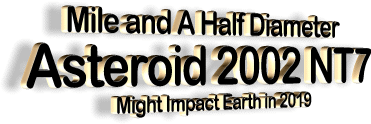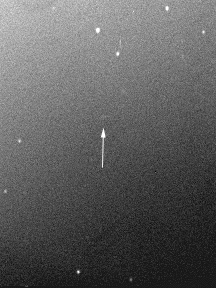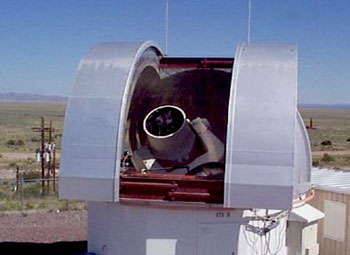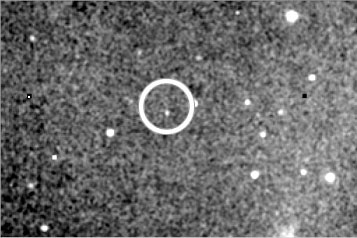|

by Linda Moulton Howe
2002
from
EarthFiles Website
recovered through
WayBackMachine Website
"We are talking about a global
disaster of apocalyptic dimensions if an asteroid that size were
to hit us."
Benny Peiser
Ph.D., Liverpool John Moores
University, U. K.

Asteroid 2002 NT7
currently tops the Impact Risk list of NASA/JPL's Near-Earth
Object Program because current calculations place it crossing
the earth's orbital path on or about February 1, 2019, or other
possible later dates. NASA says, "While this prediction is of
scientific interest, the probability of impact is not large
enough to warrant public concern."
July 25, 2002 Liverpool, England
- The newly discovered potential threat
to the earth in another seventeen years is known by scientists as
"Asteroid 2002 NT7." It was discovered on July 9, 2002 by
researchers from M.I.T. (Massachusetts Institute of Technology) and
the Lincoln Near Earth Asteroid Research (LINEAR) project funded by
the United States Air Force and NASA.
The goal of the LINEAR program is to
demonstrate the application of technology, originally developed for
the surveillance of earth orbiting satellites, to the problem of
detecting and cataloging Near Earth Asteroids (also referred to as
Near Earth Objects, or NEOs) that threaten the Earth.

GEODSS telescope
in LINEAR program looking for asteroids, comets and "Unusual
Objects," at M.I.T.'s Lincoln Laboratory's Experimental Test
Site, White Sands Missile Range, Socorro, New Mexico. Image
courtesy M.I.T., USAF and NASA.

Klet Observatory in the Czech Republic has photographed the
"Potentially Hazardous Asteroid 2002 NT7,"
shown in white circle
above.
First discovered on July 9 by MIT's Linear Observatory in
New Mexico,
NT7 orbits the sun every 837 days and can only be
seen in the Southern Hemisphere.
Image was photographed on July
19, 2002, with Klet Observatory CCD camera.
The field of view is
16 to 10 arcminutes with north to the top and west to the right.
The LINEAR program uses a pair of
GEODSS
telescopes at Lincoln Laboratory's Experimental Test Site (ETS) on
the White Sands Missile Range in Socorro, NM. The telescopes are
equipped with Lincoln Laboratory developed CCD electro-optical
detectors and collected data is processed on site to generate
observations.
Observations are then sent to the main
Lincoln Laboratory site on Hanscom, AFB in Lexington, MA where they
are linked from night to night, checked, and sent to the Minor
Planet Center (MPC). The MPC assigns designations to LINEAR's new
discoveries of NEOs, comets, Unusual Objects, and main belt
asteroids.
A scientist in England has organized an e-mail network to monitor
asteroid and comet alerts and was the first person to speak out
about NT7. Benny Peiser, Ph.D., is a Senior Lecturer in Social
Anthropology at Liverpool John Moores University in Liverpool. He is
a social anthropologist who studies the affect of large events such
as asteroid impacts on the earth, environment and social evolution.
Interview:
Since July 9, I understand you've
had 100 observations of the NT7 asteroid. Can you describe what
the trajectory seems to be and what the threat potential is to
earth?
Given that we only have two weeks of observations, the orbital
arc we have so far is very short and the trajectory is very
uncertain. Nevertheless, we can make calculations about what the
probability is of this arc to eventually move through the earth.
This object has a fairly high rating. In other words, it has a
relevant impact probability. But in all likelihood like in other
previous cases, additional observations will almost certainly
eliminate this potential hazard.
Is it true this is the first asteroid to have been given a
positive value on the Palermo Technical Scale, meaning greatest
potential for earth impact observed so far?
Yes and no. Yes for an object with an impact probability in the
near future. There was another asteroid called 1950 DA that
actually had an impact date some 800 years in the future, which
also showed up in that category. But given that the impact date
for that asteroid is some 800 years in the future, it does not
really rank in the same class.
February 1, 2019 could be the first potential date of the
asteroid's orbital collision with earth?
Indeed.
If this is on a potential impact with earth in only 17 more
years, why has no one reported NT7 before as a possible asteroid
threat?
Because it has a very peculiar inclination and really only shows
up close to the earth in the Southern Hemisphere. And in the
Southern Hemisphere, we do not have any search programs. Because
of the asteroid's peculiar inclination and the fact that it
comes closest to earth, especially approaching the earth from
the Southern Hemisphere, it has not been spotted. We thought
initially that old photographs might be archived somewhere that
would have this object already on one of the plates. But it
might turn out that this is indeed the first time that it was
observed.
Is it true that NT7 orbits the
sun every 837 days?
Yes, that's true.
Is it odd that it had not been discovered before July 2002?
Not really because so far we have only discovered 600 asteroids
in that size category that is, asteroids larger than 1
kilometer in size. This one is two kilometers, about 1.5 miles
wide. We expect there to be some 700 asteroids in that size
category which have not been discovered yet. So, we think this
is one of those.
You were quoted by the BBC as saying, "This asteroid has now
become the most threatening object in the short history of
asteroid detection."
Yes, I said that. That is true. I should have said potentially
the most hazardous. This is only a potential threat. Obviously
it is the asteroid that has the highest impact probability and
the shortest impact date and it is fairly large. We've had
similar objects in the past with a lower impact probability and
a larger warning time and a smaller size. But this one is a
historic first in that it is rather big and it has a fairly
short warning period and a fairly relevant impact probability.
How long do you think it will be that enough observations are
made for astronomers and physicists to be confident about
whether this is on an impact course or not?
I expect the object to be eliminated from our list within the
next three or four months. As I said, the object will be visible
for the next 18 months or so, so there are many opportunities to
follow up the object and to refine the orbit and to almost
certainly prove that it's not going to hit.
What if the calculations turn out to support an impact?
Well, then God help us! This is a very large object that we do
not want even to contemplate hitting us. It would plunge our
planet back into stone age conditions. It would lead to mass
starvation on a global level and we don't want even to think
about these kinds of scenarios which are any how extremely
unlikely.
But isn't the reason why there are asteroid searches because
of the potential threat of impact? It has happened in our
earth's history before.
Oh, absolutely! And it's going to happen in the future unless we
take this risk seriously enough and look out for this object and
eventually some time in the future, we will have to deflect an
object that will be on a collision course. It's just a question
of time. Sooner or later, we will find an object, hopefully not
such a large one that is on a collision course. It might take
another 100 or 1000 years or tomorrow. No one can tell.
Therefore, we need to be prepared.
These things seem to keep creeping up on us and being
discovered just very suddenly. We really don't seem to know what
exactly is coming through our solar system and crossing near the
earth's orbital plane until sometimes an object has already
passed us. What effect would an asteroid 1.5 miles in diameter
have upon impact with earth?
If an asteroid that size would impact the earth, it would throw
up so much dust into the atmosphere and possibly into the
stratosphere that the sun would be blocked out for a long period
of time, perhaps a whole year or longer. It would destroy all
the crops worldwide and it would consequently lead to mass
starvation apart from the physical damage at the impact. If it
were to impact one of the oceans, all the coasts and all the
towns and cities around the coasts would be destroyed by huge
tidal waves. We are talking about a global disaster of
apocalyptic dimensions if an asteroid that size were to hit us.
However, we should also remember that an asteroid that size only
hits the earth perhaps once every one or two million years and
there is no reason to believe it will actually happen right at
our generation. The likelihood is extremely small that we are
the unlucky ones. We've survived for the past 5 million years
and I am pretty confident that we can solve this problem of
incoming asteroids in the next 100 or 200 years. That's the time
span I suggest it will take for a planetary defense system to be
established and to work efficiently.
But it is a fact, is it not, that currently for the next
three or four months no one will know for certain whether the
February 1, 2019 or later dates are a reality. What happens if
scientists calculate and find validity to an impact date in
2019. Do we have enough time over the next 17 years to do
anything to stop a 1.5 mile diameter asteroid?
The short answer is most likely not. Most likely 17 years would
not be enough to develop the technology necessary. However, the
human species is very clever and has always managed so far to
escape all the disasters thrown at us. So perhaps we would be
able to do something about it. But currently the estimates for
an efficient system of planetary protection and deflection
program is estimated between 30 and 70 years. But with the
advance of technology, perhaps this might actually decrease. If
we ever were to face with such a scenario, I'm pretty sure the
global, the community would get together and put all the
resources into a program that would try to deflect the object
long before it hits the earth.
For those of us who would like to keep track of the NT7
asteroid, what is the best way to do that on the net?
There are a
number of websites which update the risk assessment
of this and other asteroids on a daily basis. All the
observations that come in are put into computers and the risks
are assessed. The best site in the U. S. is at
JPL at the Near
Earth Office of NASA. It's a program called Sentry which lists
all the asteroids on a potential collision course and that
website gives lots of information about all the asteroids
currently listed as meriting monitoring or concern."
|



